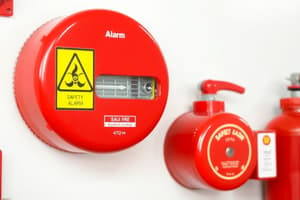Podcast
Questions and Answers
What type of hazard is associated with liquefied gases like liquid nitrogen?
What type of hazard is associated with liquefied gases like liquid nitrogen?
- High pressure hazard (correct)
- Electrical hazard
- Radiation hazard
- Chemical hazard
Which of the following substances is NOT mentioned as an example of products with pyrophoric properties?
Which of the following substances is NOT mentioned as an example of products with pyrophoric properties?
- Alkali metals
- Methane (correct)
- White phosphorus
- Tert-butyllithium
What is the defining characteristic of a liquid with a flashpoint below 93.3 oC?
What is the defining characteristic of a liquid with a flashpoint below 93.3 oC?
- It is highly toxic
- It is highly viscous
- It gives off vapors easily (correct)
- It is radioactive
What is the main hazard associated with flammable solids?
What is the main hazard associated with flammable solids?
Which hazard class includes products that can catch fire very quickly if exposed to air?
Which hazard class includes products that can catch fire very quickly if exposed to air?
Why are refrigerated liquefied gases hazardous?
Why are refrigerated liquefied gases hazardous?
What is the main purpose of the Canada Consumer Product Safety Act?
What is the main purpose of the Canada Consumer Product Safety Act?
Which of the following is the most common route of entry for hazardous products to affect human health?
Which of the following is the most common route of entry for hazardous products to affect human health?
Which of the following substances can cause lung cancer when inhaled?
Which of the following substances can cause lung cancer when inhaled?
Which of the following is a measure of the toxicity of a substance?
Which of the following is a measure of the toxicity of a substance?
What is the main purpose of the Pest Control Products Act?
What is the main purpose of the Pest Control Products Act?
Which of the following is NOT a route of entry for hazardous products to affect human health?
Which of the following is NOT a route of entry for hazardous products to affect human health?
What information is required on a workplace label for a hazardous product?
What information is required on a workplace label for a hazardous product?
When is a workplace label not required for a hazardous product?
When is a workplace label not required for a hazardous product?
What is the main purpose of a Safety Data Sheet (SDS)?
What is the main purpose of a Safety Data Sheet (SDS)?
Which of the following is not a required section of a WHMIS 2015 SDS?
Which of the following is not a required section of a WHMIS 2015 SDS?
When must an SDS be updated?
When must an SDS be updated?
What is the purpose of a workplace label for a hazardous product?
What is the purpose of a workplace label for a hazardous product?
Which hazard class is represented by a flame over a circle symbol?
Which hazard class is represented by a flame over a circle symbol?
Which type of products may react violently when agitated or under certain conditions?
Which type of products may react violently when agitated or under certain conditions?
What type of hazard does the skull and crossbones symbol represent?
What type of hazard does the skull and crossbones symbol represent?
Products indicated by a flame over circle symbol may cause what type of hazards?
Products indicated by a flame over circle symbol may cause what type of hazards?
Which substance is an example of a corrosive material that can damage metals?
Which substance is an example of a corrosive material that can damage metals?
Which hazard class is associated with the exploding bomb symbol?
Which hazard class is associated with the exploding bomb symbol?
What does WHMIS stand for?
What does WHMIS stand for?
What is the primary purpose of WHMIS?
What is the primary purpose of WHMIS?
Where can workers find information about hazardous products according to WHMIS?
Where can workers find information about hazardous products according to WHMIS?
What is the purpose of hazard categories in WHMIS?
What is the purpose of hazard categories in WHMIS?
How are hazard categories organized in WHMIS?
How are hazard categories organized in WHMIS?
In the context of WHMIS, what do LEL and UEL stand for?
In the context of WHMIS, what do LEL and UEL stand for?
Flashcards are hidden until you start studying
Study Notes
Workplace Labels
- Required when: hazardous product is made or decanted in the workplace, or supplier label is lost or unreadable
- Must include: product name, safe handling precautions, and reference to Safety Data Sheet (SDS)
Safety Data Sheets (SDS)
- Provides detailed information about hazardous products
- Updated when: new information changes product classification, handling or storage, or protection from hazards
- 15 main sections of information in WHMIS 2015 SDS:
- Product Identification
- Hazard Identification
- Composition/Information on Ingredients
- First Aid Measures
- Firefighting Measures
- Accidental Release Measures
- Handling and Storage
- Exposure Controls/Personal Protection
- Physical and Chemical Properties
- Stability and Reactivity
- Toxicological Information
- Ecological Information
- Disposal Considerations
- Transport Information
- Regulatory Information
Hazard Symbols
- Flame (for fire hazards): Flammable gases, Flammable aerosols, Flammable liquids, Flammable solids
- Pyrophoric liquids, Pyrophoric solids, Pyrophoric gases: products that can catch fire spontaneously
- Self-heating substances and mixtures: products that may catch fire when exposed to air
- Corrosion (for corrosive damage to metals, as well as skin, eyes): Skin corrosion/irritation, Serious eye damage/eye irritation, Corrosive to metals
- Exploding bomb (for explosion or reactivity hazards): Self-reactive substances and mixtures, Organic peroxides
- Skull and crossbones (can cause death or toxicity with short exposure to small amounts): Acute toxicity
Studying That Suits You
Use AI to generate personalized quizzes and flashcards to suit your learning preferences.



